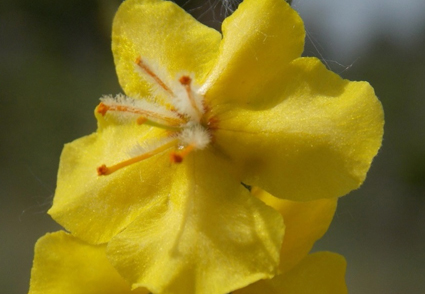Abstract
Verbascum salicifolium is described and illustrated as a species new to science based on morphological and molecular evidence. Analysis of chloroplast genome markers indicated the inclusion of the new species within a group of morphologically dissimilar taxa, whereas the closest morphologically related species is sister to that group. Additionally, the chromosome number (2n = 36) and karyotype microphotograph of the new species are provided. The known distribution of V. salicifolium is confined to the eastern shores of Doiran Lake, where a single, threatened population exists. Thus, the appropriate conservation status for the species is recommended according to IUCN criteria.
References
Bertoloni, A. (1810) Rariorum Italiae plantarum. Tomus III. Raynerii Prosperi, Pisa, 125 pp.
Boissier, E. (1856) Diagnoses plantarum Orientalium novarum. Series secunda, No 3. B. Herrmann, Leipzig, 177 pp.
Bornmüller, J. (1922) Neues und Bemerkenswertes über Verbascum-Arten Mazedoniens. Repertorium Specierum Novarum Regni Vegetabilis 18: 133–141. https://doi.org/10.1002/fedr.4870183205
Bornmüller, J. (1930) Ueber einige neue Verbascum-Arten, Sektion Lychnitis, der Flora Anatoliens. Repertorium Specierum Novarum Regni Vegetabilis 29–32: 354–365. https://doi.org/10.1002/fedr.4870272905
Darlington, C.D. & La Cour, L. (1969) The handling of chromosomes. George Allen and Unwin, London, 272 pp.
Dimopoulos, P., Raus, Th., Bergmeier, E., Constantinidis, Th., Iatrou, G., Kokkini, S., Strid, A. & Tzanoudakis, D. (2013) Vascular plants of Greece: an annotated checklist. Botanischer Garten und Botanisches Museum Berlin-Dahlem, Berlin, & Hellenic Botanical Society, Athens, 372 pp.
Edgar, R.C. (2004) MUSCLE: multiple sequence alignment with high accuracy and high throughput. Nucleic Acids Research 32: 1792–1797. https://doi.org/10.1093/nar/gkh340
Felsenstein, J. (1985) Confidence limits on phylogenies: an approach using the bootstrap. Evolution 39: 783–791. https://doi.org/10.1111/j.1558-5646.1985.tb00420.x
Ferguson, I.K. (1971) Notes on the genus Verbascum (Scrophulariaceae). Botanical Journal of the Linnean Society 64: 229–233.
Fischer, E. (2004) Scrophulariaceae. In: Kubitzki, K. & Kadereit, J. (Eds.) The Families and Genera of Vascular Plants, Volume VII. Springer, Berlin Heidelberg, pp. 333–432. https://doi.org/10.1007/978-3-642-18617-2_21
Franchet, M.A. (1874) Études sur les Verbascum de la France et de l’ Europe centrale. Bulletin de la Société Archéologique, Scientifique et Littéraire du Vendômois 13: 158–180.
Godron, D.A. (1853) Florula junenalis. Boehm, Montpellier, 48 pp.
Halácsy, E. von (1890) Beiträge sur Flora der Balkanhalbinsel. Oesterreichische botanische Zeitschrift 40: 404–406. https://doi.org/10.1007/BF01790295
Healey, A., Furtado, A., Cooper, T. & Henry, R.J. (2014) Protocol: A simple method for extracting next-generation sequencing quality genomic DNA from recalcitrant plant species. Plant Methods 10: 21. https://doi.org/10.1186/1746-4811-10-21
Huber-Morath, A. (1978) Verbascum L. In: Davis, P. (Ed.) Flora of Turkey and the East Aegean Islands, Vol 6. Edinburgh University Press, Edinburgh, pp. 461–603.
IUCN (2021) The IUCN Red List of Threatened Species. Version 2021-3. Available from: https://www.iucnredlist.org (Accessed 5 December 2021)
Kumar, S., Stecher, G., Li, M., Knyaz, C. & Tamura, K. (2018) MEGA X: Molecular evolutionary genetics analysis across computing platforms. Molecular Biology and Evolution 35: 1547–1549. https://doi.org/10.1093/molbev/msy096
Lamarck, J.P. (1797) Encyclopédie méthodique. Botanique. Vol. 4. Henri Agasse, Paris, 764 pp.
Levan, A., Fredga, K. & Sandberg, A.A. (1964) Nomenclature for centromeric position on chromosomes. Hereditas 52: 201–220. https://doi.org/10.1111/j.1601-5223.1964.tb01953.x
Linnaeus, C. (1753a) Species plantarum. Salvius, Stockholm, 560 pp.
Linnaeus, C. (1753b) Species plantarum. Tomus II. Salvius, Stockholm, 639 pp.
Linnaeus, C. (1759) Systema naturae. Tomus II. Salvius, Stockholm, 555 pp.
Liveri, E. (2021) Phylogeny and biogeography of Campanula L. section Quinqueloculares (Boiss.) Phitos (Campanuloideae, Campanulaceae). University of Patras, Patras, 246 pp.
Murbeck, S. (1933) Monographie der Gattung Verbascum. Hakan Ohlsson, Lund, 630 pp.
Murbeck, S. (1939) Weitere Studien über die Gattungen Verbascum und Celsia. C.W.K. Gleerup, Lund, 70 pp.
Nei, M. & Kumar, S. (2000) Molecular evolution and phylogenetics. Oxford University Press, New York, 348 pp.
Östergren, G. & Heneen, W.K. (1962) A squash technique for chromosome morphological studies. Hereditas 48: 332–341. https://doi.org/10.1111/j.1601-5223.1962.tb01817.x
Rice, A., Glick, L., Abadi, S., Einhorn, M., Kopelman, N.M., Salman-Minkov, A., Mayzel, J., Chay, O. & Mayrose, I. (2015) The Chromosome Counts Database (CCDB) – a community resource of plant chromosome numbers. New Phytologist 206: 19–26. https://doi.org/10.1111/nph.13191
Stebbins, G.L. (1971) Chromosomal evolution in higher plants. Edward Arnold, London, 216 pp.
Tenore, M. (1826) Ad florae neopolitanae prodromum. Appendix VI. R. Marotta et Vanspandoch, Naples, 34 pp.
WCVP (2022) World Checklist of Vascular Plants, version 2.0. Facilitated by the Royal Botanic Gardens, Kew. Published on the Internet; http://wcvp.science.kew.org/ (Retrieved 15 February 2022)


